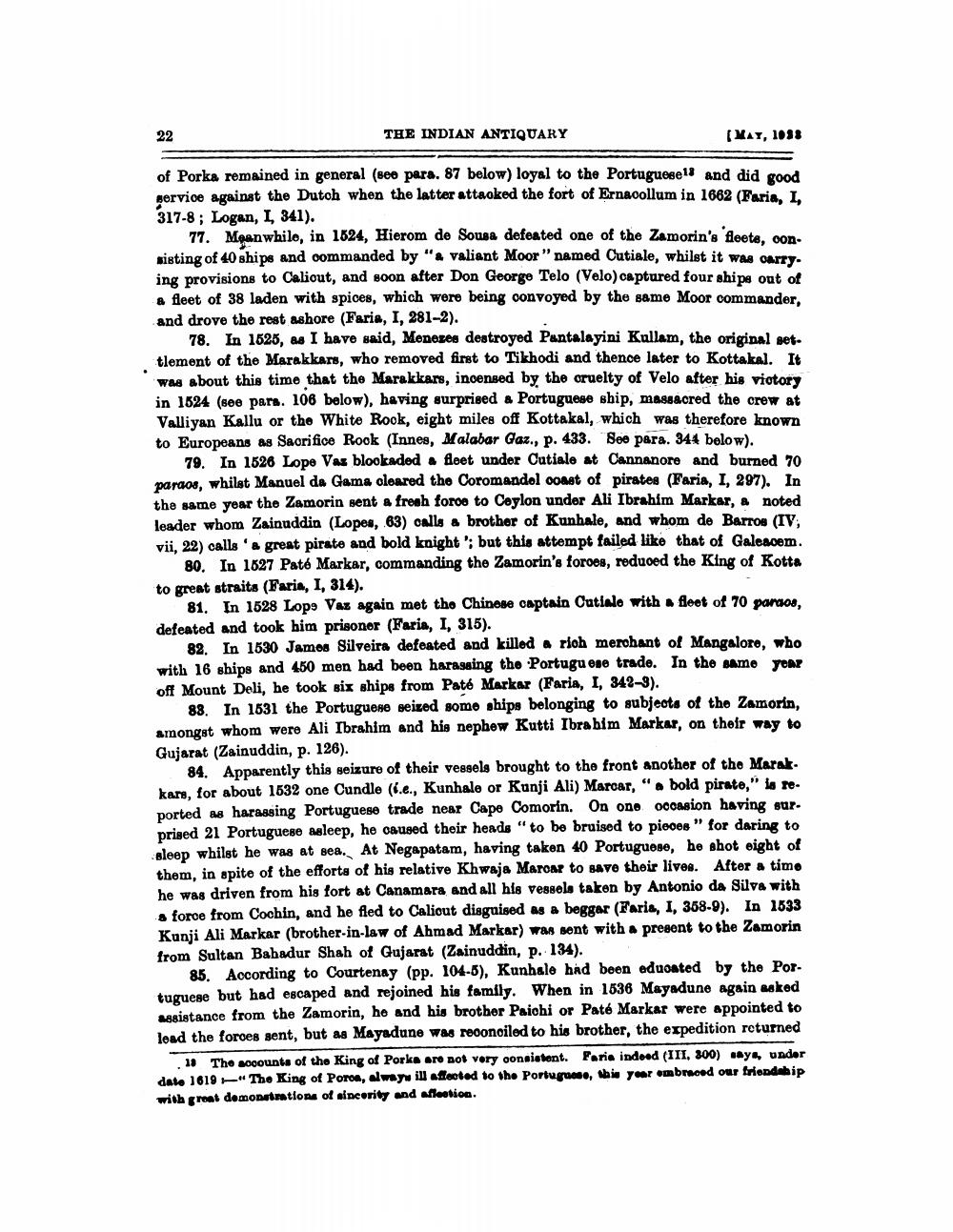________________
22
THE INDIAN ANTIQUARY
(May, 1958
of Porka remained in general (see para. 87 below) loyal to the Portuguese18 and did good service against the Dutch when the latter attacked the fort of Ernacollum in 1662 (Faria. L. 317-8; Logan, L, 341).
77. Meanwhilo, in 1624, Hierom de Sousa defeated one of the Zamorin's floete. oonsisting of 40 ships and commanded by "& valiant Moor" named Cutiale, whilst it was carry. ing provisions to Calicut, and soon after Don George Telo (Velo) captured four ships out of a fleet of 38 laden with spices, which were being convoyed by the same Moor commander, and drove the rest ashore (Faria, I, 281-2).
78. In 1526, as I have said, Menezes destroyed Pantalayini Kallam, the original set. tlement of the Marakkars, who removed first to Tikhodi and thence later to Kottakal. It was about this time that the Marakkars, incensed by the cruelty of Velo after his victory in 1624 (see pars. 106 below), having surprised a Portuguese ship, massacred the crew at Valliyan Kallu or the White Rook, eight miles off Kottakal, which was therefore known to Europeans as Saorifice Rook (Innes, Malabar Gaz., p. 433. Soe para. 344 below).
79. In 1526 Lope Vas blookaded fleet under Outiale at Cannanore and burned 70 paraos, whilst Manuel da Gama oloared the Coromandel coast of pirates (Faria, I, 297). In the same year the Zamorin sent a fresh foroo to Coylon under Ali Ibrahim Markar, a noted leader whom Zainuddin (Lopes, 63) calls a brother of Kunhale, and whom de Barros (IV, vii, 22) calls a great pirate and bold knight'; but this attempt failed like that of Galeacem.
80. In 1627 Paté Markar, commanding the Zamorin's foroes, reduoed the King of Kotta to great straits (Faria, I, 314).
81. In 1628 Lope Vaz again met the Chinese captain Cutialo with fleet of 70 pardos, defeated and took him prisonor (Faria, I, 315).
82. In 1530 Jamos Silveira defeated and killed a rich merchant of Mangaloro, who with 16 ships and 450 men had been harassing the Portuguese trade. In the same YOAP oft Mount Deli, he took six ships from Paté Markar (Faria, I, 342-9).
88. In 1631 the Portuguese seized some ships belonging to subjects of the Zamorin, amongst whom were Ali Ibrahim and his nephew Kutti Ibrahim Markar, on their way to Gujarat (Zainuddin, p. 126).
84. Apparently this seizure of their vessels brought to the front another of the Marak. kars, for about 1632 one Cundle (i.e., Kunhale or Kunji Ali) Marcar," bold pirate," la reported as harassing Portuguese trade near Cape Comorin. On one occasion having sur. priged 21 Portuguese asleep, he caused their heads "to be bruised to pieces " for daring to sleep whilst he was at sea. At Negapatam, having taken 40 Portuguese, he shot sight of them, in spite of the efforts of his relative Khwaja Maroar to save their lives. After a timo he was driven from his fort at Canamara and all his vessels taken by Antonio da Silva with
force from Cochin, and he fled to Caliout disguised as a beggar (Faria, I, 368-9). In 1633 Kunji Ali Markar (brother-in-law of Ahmad Markar) was sent with a present to the Zamorin from Sultan Bahadur Shah of Gujarat (Zainuddin, p. 134).
85. According to Courtenay (pp. 104-5), Kunhale had been aduoated by the Por. tuguese but had escaped and rejoined his family. When in 1636 Mayadune again askod assistance from the Zamorin, he and his brother Paichi or Paté Markar were appointed to lead the foroes gent, but as Mayadune was reconciled to his brother, the expedition returned
11 The accounts of the King of Porks are not very consistent. Para indood (III, 300) says under dato 1619 "The King of Poros, alway, ill affected to the Portugees, Main your embraced our friendship with great demonstrations of sincerity and letion.




